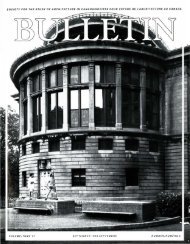CANADA - SEXTONdigital
CANADA - SEXTONdigital
CANADA - SEXTONdigital
You also want an ePaper? Increase the reach of your titles
YUMPU automatically turns print PDFs into web optimized ePapers that Google loves.
J ULIAN SMITH > ESSAY I ESSAI<br />
FIG. 12. COPPERPLATE ETCHING FROM JAMES STUART AND NICHOLAS REVETI,<br />
ANTIQUfTIES OF ATHENS, VOL II, CHAPTER 1, PLATE IV, FIGURE 1, 'A VIEW<br />
OF THE EASTERN PORTICO OF THE PARTHENON'.<br />
FIG. 13. COPPERPLATE ETCHING FROM JAMES STUART AND NICHOLAS REVETI, ANTIQUITIES<br />
OF ATHENS, VOL. II, CHAPTER 1, PLATE VI, 'ELEVATION OF THE EASTERN PORTICO OF<br />
THE PARTHENON'.<br />
In conclusion I return to the challenge of<br />
dealing with emerging modernism. Our<br />
principles for conservation come out of<br />
a nineteenth-century preoccupation with<br />
monuments from the preindustrial age.<br />
Medieval cathedrals and Renaissance palaces<br />
were built by hand, with an obvious<br />
exploration of the material qualities and<br />
textures involved. There is an authorship<br />
that has to do with craftsmanship, and<br />
that therefore defines authenticity in material<br />
terms. The fundamental principle in<br />
such cases is retention of original material<br />
and differentiating it from contemporary<br />
interventions. When John Ruskin and William<br />
Morris were developing conservation<br />
theory and practice through the Society<br />
for the Protection of Ancient Buildings,<br />
they were taking preindustrial monuments<br />
as their point of reference.<br />
In this context, a limited repair and upgrade<br />
option would be a reasonable approach.<br />
The repair itself would be part of<br />
an ongoing evolution, with the goal being<br />
to arrest or slow down the processes<br />
of decay but not deny their reality.<br />
In the case of emerging modernism, the<br />
application of the principles becomes<br />
more complicated. If formal abstraction<br />
and purity of form become fundamental,<br />
it is not clear how one incorporates<br />
repair in the same way. We tend to return<br />
examples of modernism to an abstract<br />
ideal that is considered appropriate to<br />
their underlying value. The conservation<br />
principles that apply to modernist<br />
architecture are not well understood or<br />
enunciated.<br />
The Vimy Memorial is not fully part of<br />
the modernist tradition. The cladding was<br />
still stone, hand-tooled and finished. The<br />
sculptural work relied on traditional stone<br />
carving techniques, although Allward did<br />
use pantographs to transfer the design<br />
and left the marks of this technology on<br />
the surface perhaps as subtle reminders<br />
of this application. But he also used re -<br />
inforced concrete, then in its infancy, as<br />
the underlying structural system. In fact,<br />
his combination of stone and concrete in<br />
a new and untested way partly led to the<br />
gradual degradation of the monument<br />
and necessitated a severe intervention<br />
approach. Similar to Allward's own mixture<br />
of new and age-old techniques, the<br />
restoration at Vimy was a subtle blend.<br />
It involved a strong commitment to<br />
preserving every single original stone that<br />
was salvageable either as is or through<br />
any one of a variety of sophisticated<br />
repair techniques; at the same time the<br />
introduction of new elements was done<br />
seamlessly, without the usual regard for<br />
distinguishing old and new. The surfaces<br />
were cleaned, as in Allward's time, to create<br />
a uniform surface. The tooling and the<br />
relettering were carried across the joints<br />
as before. Each small scale decision was<br />
part of a larger philosophical commitment-<br />
to respect the intellectual intent<br />
as much as the physical manifestation of<br />
Allward's work. The conditions of emerging<br />
modernism that had shaped the original<br />
were used to shape the restoration.<br />
NOTES<br />
1. Section 9.0, " Options Analysis and Recom <br />
mended Option", in Vi my Monument Historic<br />
Structures Report, Heritage Conservation Program,<br />
Public Works and Government Services<br />
Canada, 2002.<br />
2. For a detailed discussion of the full restoration<br />
process, see Wertheimer, Eve, 2007, Documentation<br />
of the Vimy Monument Restoration,<br />
Heritage Conservation Directorate, Public<br />
Works and Government Services Canad.<br />
56 JSSAC I JSEAC 33 > N• 1 > 2008
















